

| Invertebrate news 2014 |
| Insect and Arachnid news and sightings from around Nottinghamshire |
| October
Red Admiral migration We recently recorded Red Admirals moving the county, with seven noted moving south on 05/10/14 in an hour, from a vantage point near Market Warsop, before the movement petered out. Fine weather a week later on 12/10/14, produced a total of 35 south-west in 1.5 hours observing. The movement produced a more concentrated period of migration just before 13:00h, which is shown in the graph below. We stopped recording at 13:30h. |
||
 |
||
| Two more Nottinghamshire sites for Nigma walckenaeri This delightful green spider has been found at two more Nottinghamshire sites, both in the south of the county. We found several on Ivy growing at Trent Lane Industrial Estate on August 27th, then Tim Sexton found a number of adults on Ivy at Attenborough Nature Reserve in early October. This spider is clearly widespread now and can be looked for wherever Ivy grows. Urban areas should especially be checked. |
||
| Two recent records of the Western
Conifer Seed Bug We've recently received news of two occurrences of the Western Conifer Seed Bug (Leptoglossus occidentalis) from two Nottinghamshire sites. The records are from Hucknall (recorder unknown) on September 29th and at Balderton, Newark (Newman, J.) on September 30th 2014. Nottinghamshire's first record was found in a bedroom at Eakring (Worthington, M.) on September 27th 2009, followed two years later by another on the wall of a house in Carlton, Nottingham on September 29th 2011 (Dutton, A.) . Its very interesting to note the extremely similar dates. The Western Conifer Seed Bug is a large North American species. It was recorded in Europe (Italy) in 1999, possibly via imported timber and has since spread rapidly, appearing in the UK for the first time in 2007 at Weymouth College (Ford, B.) There were further records during the latter part of 2008, with most records coming from MV moth traps operated along the south and south-east coasts, with adults even reaching inland, from Quorn in Leicestershire (Gamble, P.)and at Charlesworth in Derbyshire (recorder unknown). |
||
| Another
site for Chrysolina americana in
Mansfield Chrysolina americana, otherwise known as the Rosemary Beetle, is obviously spreading its range, with 26 beetles found at The Patchills in Mansfield on September 24th. This is just a few hundred meters from another known site on Ling Forest Road. |
||
| Alder Leaf Beetle
arrives in Nottinghamshire A rare beetle, which was previously believed to be extinct in the UK, has just been found in Nottinghamshire for what is believed to be the first time. There have been recent UK records and the true status of Agelastica alni, is currently unknown and it currently has RDB K (Insufficiently known) status. Commonly known as the Alder Leaf Beetle, Agelastica alni was once believed to have migrant tendancies. It is an obvious species when seen, measuring around 7mm in length. Its appearence on several small Alders growing on Warsop Main Pit Top in September 2014, was surprising. There were believed to be no previous county records, but this beetle had been recorded at Dyscarr Wood in North Nottinghamshire by Pauline Bradford on June 11th 2014. |
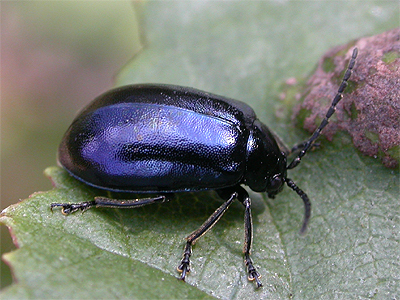 |
|
| Chrysolina
marginata in Nottinghamshire Our discovery of the Alder Leaf Beetle at Warsop Main Pit Top in September, also coincided with what we think is the second Nottinghamshire record of Chrysolina marginata, which is an elusive, nocturnal beetle found on, or near Yarrow. Chrysolina marginata is known to have occurred on just one previous occasion in Nottinghamshire, when found at Holme Pierrepont in 2011 by Adrian Dutton. Our chance discovery of this beetle, could mean that Chrysolina marginata is present at other former colliery sites across the county. |
||
| Another large increase within the Worksop population of the Leiobunum sp Harvestman | ||
| .... | ||
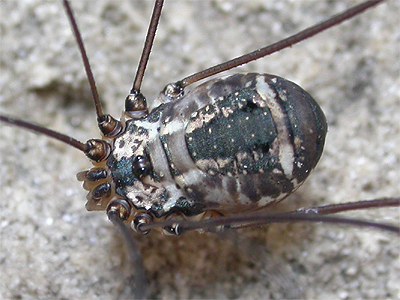 |
To date, we have made two
visits to the site and immediately found a single
aggregation of 81 Leiobunum sp, a few minutes
into our search on August 9th 2014. The final total of 202, showed that there had been an enormous increase in numbers from 2013, possibly helped by the exceptionally mild Winter. Similar daytime roost sites, were used as in previous years, but we did note a substantial increase in numbers on the north (shaded) side of Worksop Priory. Our second visit was made nearly a month later on September 7th and counts had increased to 274. There were increased numbers of Leiobunum sp recorded within all aggregations found on our first visit. The aggregation of 81 had grown to 95 and there were several other aggregations which totalled well over 30 individuals. |
|
| Another
Nottinghamshire site for the Rhododendron Leafhopper Numerous adult Rhododendron Leafhoppers (Graphocephala fennahi) were quickly found during a short targetted search at Woodthorpe Park in Nottingham on September 6th. Originally of American origin, this very attractively marked Leafhopper has been in the UK since the early 1900's, but its distribution has always been across much of the southern-half of the UK. In 2012 we found it within minutes of starting to look for it at Carr Bank Park in Mansfield in October. This was the third Nottinghamshire record following records from Wollaton Park on 10/90/89 (Fox, D.G. and Fox, H.L.) and at Newstead Abbey on 08/09/12, so it is certainly fairly widespread. This is a large species, with adults measuring around 10mm in length. Numbers of Hummingbird Hawk-moths around now Late August and the first few days of September, has seen the emergence of numerous Hummingbird Hawk-moths, following on from an arrival earlier in the year. Recent records have come from Market Warsop, Edwinstowe and Centre Parcs. Hummingbird Hawk-moths are traditionally day-flyers, but do occasionally turn up at MV light on the south coast. Almost any patch of Valerian, or Buddleia is likely to produce these fantastic moths at some time during September. As for a peak time to look, early morning, late afternoon and early evening, seem to be the best in our garden. |
||
| A second record of Juniper Shieldbug for Nottinghamshire? | ||
| .... | ||
| We are still waiting to
hear from the Hemiptera recorder for
Nottinghamshire/Derbyshire, regarding previous Juniper
Shieldbug records from Nottinghamshire, but we finally
found a thriving population of nymphs on Lawson's Cypress
in urban Mansfield at the end of August. Juniper Shieldbug is a species which we had regularly searched for, for most of the past decade, knowing of just one previous county record from Ordsall near Retford. It is known to have been spreading north from its formerly restricted range in the southern counties of the UK, for a number of years, so it should be well established in the county by now. This is a Shieldbug, which should be actively looked for urban areas, such as parks and gardens. The nymphs can be found sitting on the cones of Lawson's Cyress in warm, sunny weather. |
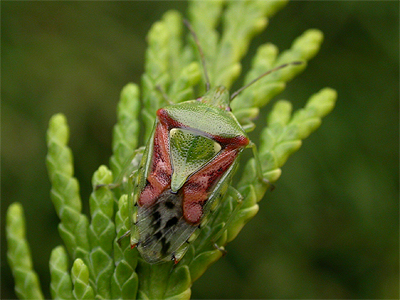 |
|
| Large
increase in the numbers of the Leiobunum
sp Harvestman at Worksop We visited Worksop Priory on 09/08/14, to make our first count of the (still) un-named Leiobunum Harvestman, present there for several years now. Our previous highest count, came in September 2013, when several aggregations totalled 46. This year, there has been a huge increase, with a count of 202 and the largest aggregation consisting of approximately 81 individuals. ...and Nigma walckenaeri present too The cemetary adjacent to Worksop Priory, continues ot hold numbers of the small, green spider Nigma walckenaeri, which was found here in 2013. Good numbers were on foliage along the northern boundary of the cemetery, but they can also be found on Ivy growing along the shadier southern wall. This is another species, which must be quite widespread in Nottinghamshire now, with a record coming earlier this year from Netherfield Ash Lagoons at Nottingham. |
||
| Hierogliphic
Ladybird at Rainworth Heath Without doubt, the Hieroglyphic Ladybird is Nottinghamshire's rarest Ladybird. The NBN Gateway lists the most recent records as Clumber Park (1981) Clipstone Heath (1987) and Budby South Forest (1989). However, the Nottinghamshire Wildlife Trust hold three records from Rainworth Heath SSSI in 2007 and 2011 and on the basis of this information, we conducted specific searches for the Hieroglyphic Ladybird in conjunction with two work experience parties and the NWT, in late July 2014. We eventually found three adults of the melanic (commonest) form, by sweeping foliage, finding all three in a small area of wet heath on 30/07/14, following this record up by finding five on a return visit the next day. Virtually all were of the melanic form. |
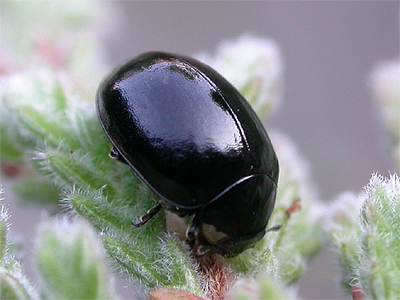 |
|
| Some
recent Nottinghamshire moth records June and July has seen good numbers of moths during the various trapping sessions we have undertaken and starting regular trapping in our garden at Market Warsop, has paid off with records of Plain Pug, Bird's Wing, the Plume Stenoptilia bipunctidactyla and Bryotropha affinis. |
||
| ....... | ||
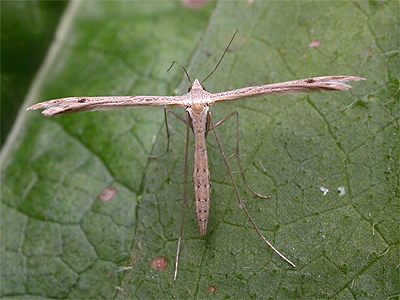 |
Other recent records have
been Fen Wainscot (only our second ever record) which was
added to the Eakring list on 18/07/14, with Black Arches
and True Lover's-knot also on the same date. Elachista triatomea was personally new for us, when an adult was photographed at Hills and Holes SSSI at Market Warsop on 19/06/14, but an occupied leafmine found in coppiced woodland at Wellow Park in April, eventually produced an adult Elachista adscitella a few weeks later. E. adscitella seems to be previously unknown in Nottinghamshire and is certainly uncommon over most of the UK, although a great deal of under recording must acount for this. A most surprising find earlier in the year, was that of a colony of Marsh Pug at Rushpool Open Space NR near Asda in Forest Town on 26/05/14. Two adults were recorded and this must be a moth which goes undetected at many similar sites and should always be looked for in suitable habitat. |
|
| ....... | ||
| Migrant
Silver-washed Fritillaries arrive in Nottinghamshire There seems to have been a genuine influx of migrant Silver-washed Fritillary in parts of the UK and Nottinghamshire over the past few weeks. Aside from the resident, introduced population at Eaton and Gamston Woods near Retford, other records have come from Nettleworth Manor near Mansfield Woodhouse, where we picked one up at the roadside on 08/07/14 and at Cotgrave (per K. Orme). Most recently, one was seen at Dyscarr Wood in the north of the county by Pauline Bradford on 18/07/14. |
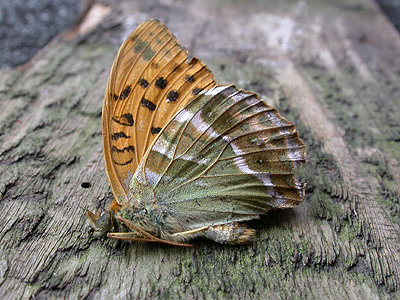 |
|
| Successful breeding and release of the Red Data Book 1 Hazel Pot Beetle | ||
| ..... | ||
|
We are very pleased to report that our
captive stock of of the RDB1 (Endangered) Hazel Pot
Beetle Cryptocephalus coryli, have successfully
over-wintered and bred. With a few adults still to emerge, we released almost 1,000 beetles in Sherwood Forest on May 12th 2014, reared from a total of 1,166 pupae. The release will help augment the Sherwood Forest colony, from which eggs were originally obtained in 2011 and the resulting adults bred from in 2012. We have retained several thousand eggs for continued breeding purposes and further release, which should emerge as adults in Spring 2014. Although larvae can be mature within a year, keeping them outside and going with the natural two year life-cycle, resulted in better quality stock. After emergence, the adults were transferred to a large bucket, netted over and kept outdoors (weather permitting) during the day, but returned indoors overnight. It soon became obvious that one bucket would not suffice, so emerging beetles had to be housed in a second set up. |
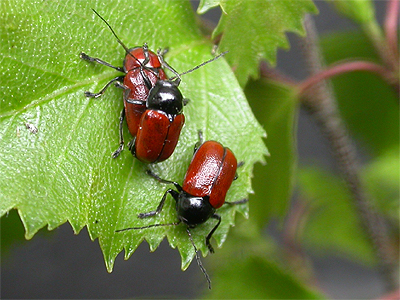 |
|
| ..... | ||
| As more adults emerged, a third set up soon became neccessary, until we eventually had to transfer them all to one large plastic container, which was similarly netted over and a door cut into the side of the container to allow access to change the foodplant ever two or three days as required. | ||
| ..... | ||
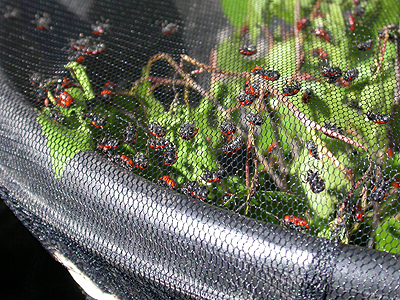 |
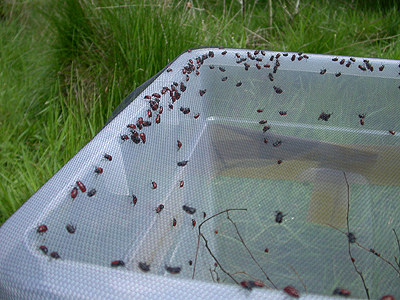 |
|
| ..... | ||
| The system has worked extremely well and we have had very few casualties, despite our efforts to ensure the water filled jars holding the Birch foodplant, was tightly blocked off. | ||
| ..... | ||
| Emergence has been
restricted to a period of about two weeks from April 26th
and is now virtually complete by May 12th. We have been
extremely pleased with the 82% emergence rate of success. After single males emerged on April 26th and 27th, two males emerged on April 28th, before 24 adults (including the first five females) appeared on April 29th. The largest number to emerge on a single day was 156 on April 30th. Numbers of emerging adults has steadily declined since, although 126 adults emerged on May 3rd. Peak time of day for emergence was found to be early afternoon, but beetles would emerge from first light and continue into the late evening. Light and probably temperature, seemed to trigger emergence and artificial light after a period of natural darkness, would see continued emergence into the early morning hours. |
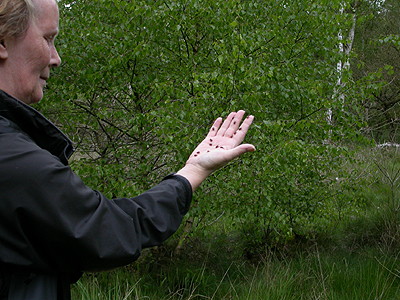 |
|
| ..... | ||
| The first
pots began to appear after a few days and the adults
habit of chewing the leaf stalk, soon meant that the
bottom of the containers had a thick layer of cut leaves.
In most cases, the adults bit the leaf off, while they
actually sitting on it. Flight in all containers was much stronger and direct than we had previously believed. It seems quite clear to us now, that outward spread of any population is distinctly probable, given the availability of suitable habitat nearby. Release of nearly 1,000 Hazel Pot Beetles took place at the Sherwood Forest Country Park on May 12th 2014. The location of release was within the boundaries of the existing colony, which was rediscovered after a 70 year absence back in 2008 and from where the parents of the released stock originated from. |
||
| Mompha langiella -
A new moth for
Nottinghamshire Tim Sexton, reserve manager of the Nottinghamshire Wildlife Trust's Attenborough Nature Reserve, recorded around 50 adult Mompha langiella in the grounds of Nottingham University in late April. This constituted the first Nottinghamshire record, later confirmed by the Notts/Derbys micro moth recorder Dave Budworth. Tim very quickly followed this up by finding the moth at Attenborough a few days later, then we also found Mompha langiella flying around Martin Dale's Mapperley garden on 30/04/14. This is obviously an over-looked moth in the county. |
||
| Two new moths for the Sherwood
Forest NNR Two recent micro moth records, have both proved to be new species for the Sherwood Forest NNR moth list. Elachista canapennella (shown right) was attracted to an MV light we ran in the Country Park on 20/04/14. |
||
| ..... | ||
| This was followed the next day, when we
found numerous larval cases of Coleophora discordella
on Bird's-foot Trefoil growing at Clipstone Old Quarter. Both species are probably quite widespread in Nottinghamshire, but under recorded and a few days before, we also found Coleophora discordella at the former sand quarry at Market Warsop. Lead-coloured Drab, Chocolate Tip and Scarce Prominent at Bevercotes Pit Wood Singles of Lead-coloured Drab and Chocolate Tip were attracted to an MV light run at Bevercotes Pit Wood on 05/04/14 and 07/04/14, with Scarce Prominent there on 21/04/14. Bevercotes Pit Wood is on the site of the former Bevercotes Colliery, near Retford. |
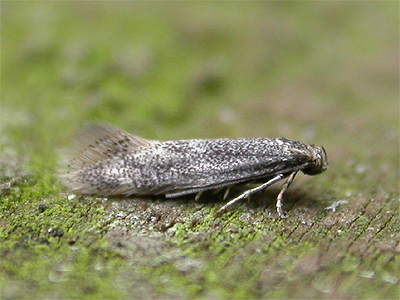 |
|
| Newstead Abbey Oil Beetles James Glendenning reports that the Oil Beetle population around the cricket pitch at Newstead Abbey is doing well so far this year, with a total of 46 found on 30/03/14. The total included at least 30 females and 16 males, all found around the cricket pitch. James also checked the car park area, but found none. Meanwhile, Ray Purser counted 43 Oil Beetles (and some fatalities through trampling etc) at the Budby South Forest colony, which continues to slowly increase each year. |
||
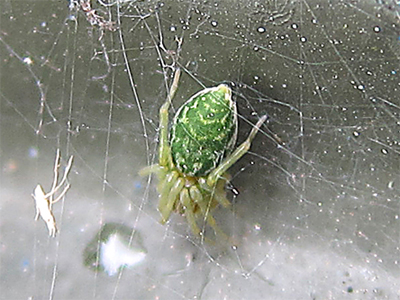 |
A second Nottinghamshire record of
the spider Nigma walckenaeri Peter Smith recently emailed us the accompanying photograph of Nigma walckenaeri, (Nottinghamshire's second record) which he had recorded from Netherfield Lagoons in mid-March 2014. This small (5mm) green spider is fast moving north through the UK and can often be easier to find in gardens and urban areas. It was recently recorded from neighbouring Leicestershire and South Lincolnshire, before being found in Nottinghamshire for the first time at Worksop Priory in August 2013. Nigma walckenaeri spins an indiscreet sheet web across the upper surface of a leaf. Plants such as Ivy are used, even when growing up telegraph poles, but Lilac is another shrub which should be checked for this spider. |
|
| Evidence supports the continued decline of the Glow Worm in Nottinghamshire |
| .. | ||
Despite still being described by some authorities as common, evidence we have gathered through our own surveying and monitoring of Nottinghamshire's Glow Worm colonies since 2008, shows that the Glow Worm is clearly in a serious decline. However, the decline is still denied by many and having no conservation status doesn't help matters, effectively meaning that site managers, owners and conservation organisations do not have to take any measures to protect Glow Worms on their sites. Yet many do, realising that the Glow Worm presents them with a great public relation, or engagement opportunity. The total number of sites in Nottinghamshire where the Glow Worm survives, is now down to just 19, effectively disappearing from 30 of its former 49 known sites. Clumber Park, Sherwood Forest and Sherwood Pines, are now the best areas in the county to see Glow Worms, but they are decreasing at an alarming rate, even at particular sites within these strongholds.Despite a site record count of 90 on July 7th 2013, Glow Worm numbers declined at Clipstone Old Quarter in Sherwood Forest for the second year in succession. In just two years, the number of female Glow Worms here, have dropped by a total of 300. In 2008 we recorded well over 200 females at nearby Sherwood Heath SSSI on two occasions, but numbers have continued to drop dramatically since then, producing just single females in each of the last three years. Sherwood Heath has now become much drier, influenced by an over zealous tree/scrub clearance programme and Bracken control (the long term removal of Bracken via rolling and herbicidal spraying) both carried out by heavy machinery. Glow Worm populations on lowland heath are clearly more prone to climatic changes than those within wooded areas, where moisture is retained within the soil for longer through shade. The start of harvesting Pines at Clipstone Old Quarter in the Winter of 2013/14, will have an effect on the Glow Worms there over the next few years at least and a succession of dry Summers, could well see a continuation of the decline. |
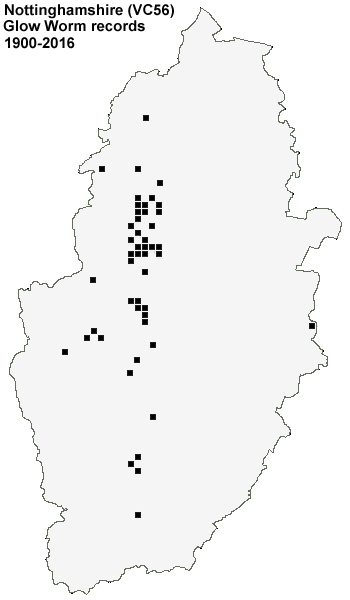 |
|
| .. | ||
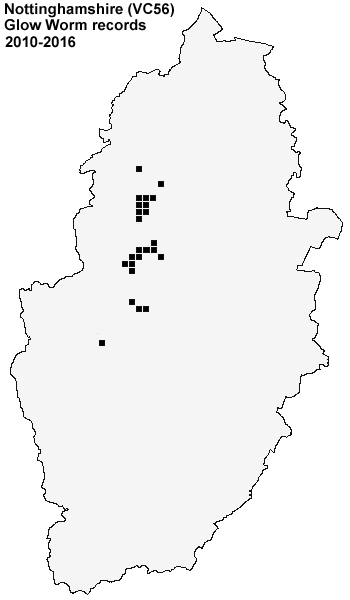 |
For some reason, Natural England East Midlands believe that Glow Worms are actually increasing at Clipstone Old Quarter and they have no interest at all in taking simple measures to help conserve them. This steadfast attitude is presently causing some public relation problems for the Forestry Commission, who manage this and many other Glow Worm sites around Nottinghamshire. The Forestry Commission have always shown great interest in having Glow Worms on their sites and at Clipstone Old Quarter, they have tried to keep everyone with differing ecological viewpoints happy and yet have ended up pleasing no one. Unfortunately, the Pine harvesting at Clipstone Old Quarter has been destructive to large areas of Glow Worm habitat and we expect the number of adults in some survey sections this Summer, to be well down on that expected, despite record numbers of larvae recorded in last Autumn. Admittedly, the Glow Worm population has little direct correllation with dead wood (Saproxylic) invertebrates and ancient woodland, for which Sherwood Forest attained its NNR status. But if one species is not doing well, then others are certainly suffering similarly and it should not matter whether these are common (expendable?) or not. The whole idea of conservation is surely to conserve all, rather than cherry pick targetted species. The decline in Glow Worm numbers over a short period of time at Sherwood Heath has been dramatic and we strongly believe (that what could well be a natural decline) is certainly being accelerated by present site management carried out under the instructions of Natural England East Midlands. So contrary to what Natural England and others may think, we have produced two maps from the NBN Gateway, showing the Glow Worm's UK distribution between 1900 and 1999 (top) and 2000-2013 (below). Make your own mind up as to whether the Glow Worm is as common now as it once used to be. First Oil Beetles of 2014With the mild Winter continuing and a gradual warming of the daily temperatures, the first Oil Beetles were found to have already emerged at their Budby South Forest site by March 3rd, over a month earlier than April 6th 2013. |
|
|
We were actually surprised to find any, and in fact were just checking the state of the site in readiness for the beetles possibly emerging in a couple of weeks time. So we were amazed to record our first Oil Beetle within a few minutes of searching, eventually recording a total of 19 Oil Beetles, all of which proved to be males. |
||
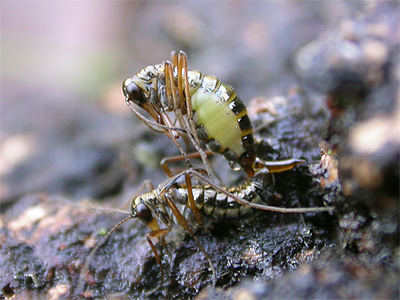 |
Snow
Flea - A new Nottinghamshire species Unusual among insects, Boreus hyemalis is active throughout the Winter months and its habit of being found on lying snow and making short jumps to escape, have led to the common name of Snow Flea. Boreus hyemalis is the less well known of the UK's four species of Mecoptera (Scorpion Flies) Described as being common across the UK, there are few records from much of England south of the Midlands and we can currently trace no other Nottinghamshire records. A single record found on the NBN Gateway and listed as 'the Nottingham area 1836' seems to been from near Codnor in Derbyshire. This mating pair (the female is always on top in Boreus hyemalis) were found within 30 minutes of searching suitable mossy habitat, at Sherwood Forest CP on January 2nd 2014. |